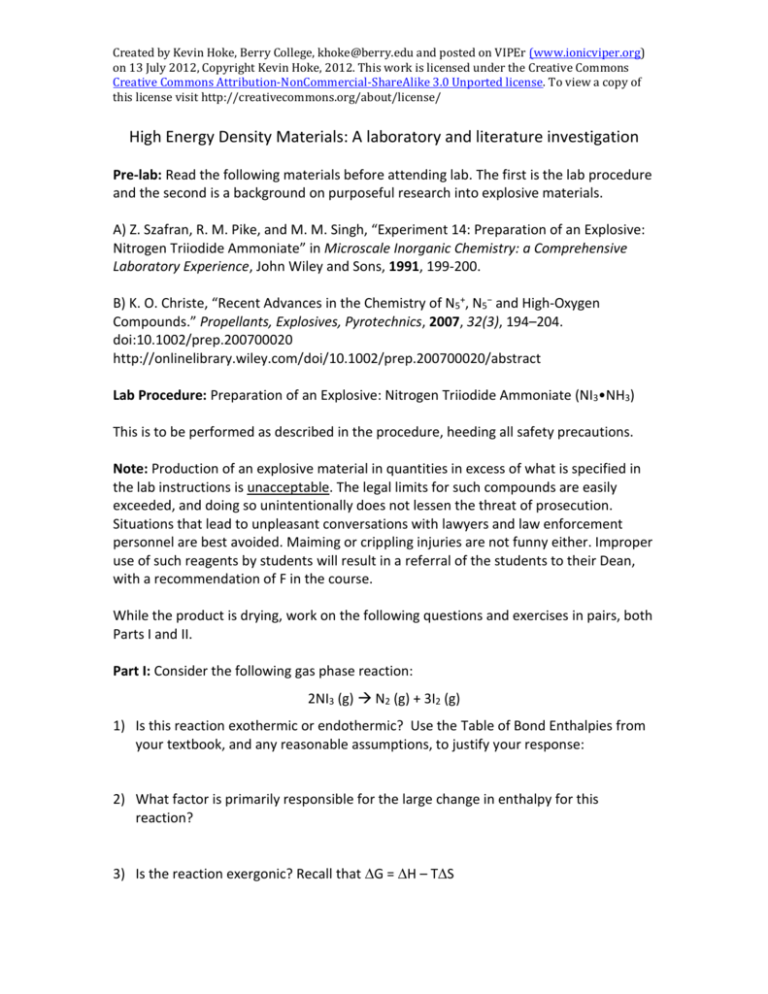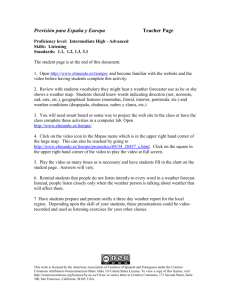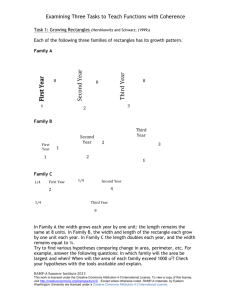Experiment: Preparation of an Explosive: Nitrogen Triiodide
advertisement

Created by Kevin Hoke, Berry College, khoke@berry.edu and posted on VIPEr (www.ionicviper.org) on 13 July 2012, Copyright Kevin Hoke, 2012. This work is licensed under the Creative Commons Creative Commons Attribution-NonCommercial-ShareAlike 3.0 Unported license. To view a copy of this license visit http://creativecommons.org/about/license/ High Energy Density Materials: A laboratory and literature investigation Pre-lab: Read the following materials before attending lab. The first is the lab procedure and the second is a background on purposeful research into explosive materials. A) Z. Szafran, R. M. Pike, and M. M. Singh, “Experiment 14: Preparation of an Explosive: Nitrogen Triiodide Ammoniate” in Microscale Inorganic Chemistry: a Comprehensive Laboratory Experience, John Wiley and Sons, 1991, 199-200. B) K. O. Christe, “Recent Advances in the Chemistry of N5+, N5− and High-Oxygen Compounds.” Propellants, Explosives, Pyrotechnics, 2007, 32(3), 194–204. doi:10.1002/prep.200700020 http://onlinelibrary.wiley.com/doi/10.1002/prep.200700020/abstract Lab Procedure: Preparation of an Explosive: Nitrogen Triiodide Ammoniate (NI3•NH3) This is to be performed as described in the procedure, heeding all safety precautions. Note: Production of an explosive material in quantities in excess of what is specified in the lab instructions is unacceptable. The legal limits for such compounds are easily exceeded, and doing so unintentionally does not lessen the threat of prosecution. Situations that lead to unpleasant conversations with lawyers and law enforcement personnel are best avoided. Maiming or crippling injuries are not funny either. Improper use of such reagents by students will result in a referral of the students to their Dean, with a recommendation of F in the course. While the product is drying, work on the following questions and exercises in pairs, both Parts I and II. Part I: Consider the following gas phase reaction: 2NI3 (g) N2 (g) + 3I2 (g) 1) Is this reaction exothermic or endothermic? Use the Table of Bond Enthalpies from your textbook, and any reasonable assumptions, to justify your response: 2) What factor is primarily responsible for the large change in enthalpy for this reaction? 3) Is the reaction exergonic? Recall that G = H – TS Created by Kevin Hoke, Berry College, khoke@berry.edu and posted on VIPEr (www.ionicviper.org) on 13 July 2012, Copyright Kevin Hoke, 2012. This work is licensed under the Creative Commons Creative Commons Attribution-NonCommercial-ShareAlike 3.0 Unported license. To view a copy of this license visit http://creativecommons.org/about/license/ 4) If you have 1.0 g of NI3 (g), how much thermal energy would be released upon its decomposition? 5) What kinetic energy would a 5 g bullet have if it is traveling at 290 m/s (a typical muzzle velocity)? How does this compare to the energy released in Question 4? 6) If 100 mg of I2 reacts completely, how many grams of NI3•NH3 could be produced? The reaction occurs as below: 3 I2(s) + 5 NH3(aq) NI3•NH3(s) + 3NH4I(aq) 7) Refer to Figure 9 in the cited paper by K. O. Christe. How many moles of high energy density material were responsible for the damage in their hood? How many grams would that be? 8) The lab instructions for today’s lab state: “Spread the moist solid out over several thicknesses of filter paper”. Comment on the key words in that instruction in terms of lab safety. 9) What are some steps that could be taken to make this lab safer? 10) What are some experiments that could be done to make this lab more educational? Do your suggestions pose any conflicts with question 9? Created by Kevin Hoke, Berry College, khoke@berry.edu and posted on VIPEr (www.ionicviper.org) on 13 July 2012, Copyright Kevin Hoke, 2012. This work is licensed under the Creative Commons Creative Commons Attribution-NonCommercial-ShareAlike 3.0 Unported license. To view a copy of this license visit http://creativecommons.org/about/license/ Part II: Go to a computer and find information on the N5+ cation, especially its early synthesis and characterization. Compare the outcomes from Google, Google Scholar, and SciFinder Scholar. You can look for Karl O. Christe, polynitrogen cation, or other keywords. 1) You need to find the first report of the synthesis of the N5+ cation. What happened when researchers first tried to use Raman vibrational spectroscopy to characterize N5+ compounds? 2) Who funded their research? Why would these agencies be interested? 3) What safety precautions do they recommend? 4) To whom did this research group dedicate their original paper on the N5+ cation? Based on a literature search, what are his areas of expertise? When you have completed your literature search and analyzed the papers, you can return to the lab for completion of the experiment.





